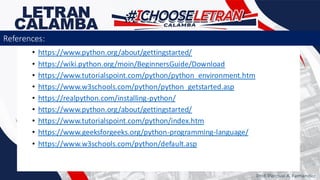Ad
Module 1 Review of Python Basics An Introduction
- 1. OBJECT ORIENTED PROGRAMMING Lec: CSIT362 / CSIT362A Lab: CSIT361L / CSIT361A-L Prof. Percival A. Fernandez
- 2. ADVANCED PYTHON PROGRAMMING Lec: CSDS042 Lab: CSDS041L Prof. Percival A. Fernandez
- 4. • Python is a popular programming language. It was created by Guido van Rossum, and released in 1991. • It is used for: • web development (server-side), • software development, • mathematics, • system scripting. What is Python Prof. Percival A. Fernandez
- 5. • Python is a high-level, general-purpose and a very popular programming language. Python programming language (latest Python 3) is being used in web development, Machine Learning applications, along with all cutting edge technology in Software Industry. • Python Programming Language is very well suited for Beginners, also for experienced programmers with other programming languages like C++ and Java. Prof. Percival A. Fernandez What is Python
- 6. • Python is a very popular general-purpose interpreted, interactive, object-oriented, and high-level programming language. • Python is dynamically-typed and garbage-collected programming language. It was created by Guido van Rossum during 1985- 1990. Python is a popular programming language. Prof. Percival A. Fernandez What is Python
- 7. • If you know Python nicely, then you have a great career ahead. Here are just a few of the career options where Python is a key skill: ▪ Game developer ▪ Web designer ▪ Python developer ▪ Full-stack developer ▪ Machine learning engineer ▪ Data scientist Prof. Percival A. Fernandez Careers with Python ▪Data analyst ▪Data engineer ▪DevOps engineer ▪Software engineer ▪Many more other roles
- 8. • Python is currently the most widely used multi-purpose, high-level programming language. • Python allows programming in Object-Oriented and Procedural paradigms. • Python programs generally are smaller than other programming languages like Java. Programmers have to type relatively less and indentation requirement of the language, makes them readable all the time. • Python language is being used by almost all tech-giant companies like – Google, Amazon, Facebook, Instagram, Dropbox, Uber… etc. Prof. Percival A. Fernandez Facts about Python
- 9. • The biggest strength of Python is huge collection of standard library which can be used for the following: • Machine Learning • GUI Applications (like Kivy, Tkinter, PyQt etc. ) • Web frameworks like Django (used by YouTube, Instagram, Dropbox) • Image processing (like OpenCV, Pillow) • Web scraping (like Scrapy, BeautifulSoup, Selenium) Prof. Percival A. Fernandez Facts about Python
- 10. • The biggest strength of Python is huge collection of standard library which can be used for the following – cont.: • Test frameworks • Multimedia • Scientific computing • Text processing and many more.. Prof. Percival A. Fernandez Facts about Python
- 11. • Python is consistently rated as one of the world's most popular programming languages. • Python is fairly easy to learn, so if you are starting to learn any programming language then Python could be your great choice. • Today various Schools, Colleges and Universities are teaching Python as their primary programming language. Prof. Percival A. Fernandez Why to learn Python
- 12. • There are many other good reasons which makes Python as the top choice of any programmer: ▪ Python is Open Source which means its available free of cost. ▪ Python is simple and so easy to learn ▪ Python is versatile and can be used to create many different things. ▪ Python has powerful development libraries include AI, ML etc. ▪ Python is much in demand and ensures high salary Prof. Percival A. Fernandez Why to learn Python
- 13. • Python is a MUST for students and working professionals to become a great Software Engineer specially when they are working in Web Development Domain. ▪ Python is Interpreted − Python is processed at runtime by the interpreter. You do not need to compile your program before executing it. This is similar to PERL and PHP. ▪ Python is Interactive − You can actually sit at a Python prompt and interact with the interpreter directly to write your programs. Prof. Percival A. Fernandez Why to learn Python
- 14. ▪ Python is Object-Oriented − Python supports Object-Oriented style or technique of programming that encapsulates code within objects. ▪ Python is a Beginner's Language − Python is a great language for the beginner- level programmers and supports the development of a wide range of applications from simple text processing to WWW browsers to games. Prof. Percival A. Fernandez Why to learn Python
- 15. • Following are important characteristics of Python Programming − ▪ It supports functional and structured programming methods as well as OOP. ▪ It can be used as a scripting language or can be compiled to byte-code for building large applications. ▪ It provides very high-level dynamic data types and supports dynamic type checking. ▪ It supports automatic garbage collection. ▪ It can be easily integrated with C, C++, COM, ActiveX, CORBA, and Java. Prof. Percival A. Fernandez Characteristics of Python
- 16. • The latest release of Python is 3.x. As mentioned before, Python is one of the most widely used language over the web. I'm going to list few of them here: • Easy-to-learn − Python has few keywords, simple structure, and a clearly defined syntax. This allows the student to pick up the language quickly. • Easy-to-read − Python code is more clearly defined and visible to the eyes. • Easy-to-maintain − Python's source code is fairly easy-to-maintain. • A broad standard library − Python's bulk of the library is very portable and cross- platform compatible on UNIX, Windows, and Macintosh. Prof. Percival A. Fernandez Reasons Python
- 17. • Interactive Mode − Python has support for an interactive mode which allows interactive testing and debugging of snippets of code. • Portable − Python can run on a wide variety of hardware platforms and has the same interface on all platforms. • Extendable − You can add low-level modules to the Python interpreter. These modules enable programmers to add to or customize their tools to be more efficient. Prof. Percival A. Fernandez Reasons to use Python
- 18. • Databases − Python provides interfaces to all major commercial databases. • GUI Programming − Python supports GUI applications that can be created and ported to many system calls, libraries and windows systems, such as Windows MFC, Macintosh, and the X Window system of Unix. • Scalable − Python provides a better structure and support for large programs than shell scripting. Prof. Percival A. Fernandez Reasons to use Python
- 19. • Python was designed for readability, and has some similarities to the English language with influence from mathematics. • Python uses new lines to complete a command, as opposed to other programming languages which often use semicolons or parentheses. • Python relies on indentation, using whitespace, to define scope; such as the scope of loops, functions and classes. Other programming languages often use curly-brackets for this purpose. Prof. Percival A. Fernandez Python Syntax compared to other programming languages
- 20. • The Python syntax defines a set of rules that are used to create Python statements while writing a Python Program. • The Python Programming Language Syntax has many similarities to Perl, C, and Java Programming Languages. However, there are some definite differences between the languages. • Python syntax can be executed by writing directly in the Command Line: Prof. Percival A. Fernandez Python - Basic Syntax
- 21. • Or by creating a python file on the server, using the .py file extension, and running it in the Command Line: Prof. Percival A. Fernandez Python - Basic Syntax
- 22. • Indentation refers to the spaces at the beginning of a code line. • Where in other programming languages the indentation in code is for readability only, the indentation in Python is very important. • Python uses indentation to indicate a block of code. • The number of spaces is up to you as a programmer, the most common use is four, but it has to be at least one. Prof. Percival A. Fernandez Python Indentation
- 23. ❖Python - Interactive Mode Programming • We can invoke a Python interpreter from command line by typing python at the command prompt as following − • Here >>> denotes a Python Command Prompt where you can type your commands. Let's type the following text at the Python prompt and press the Enter − Prof. Percival A. Fernandez Example Python Program
- 24. ❖Python - Script Mode Programming ▪ We can invoke the Python interpreter with a script parameter which begins the execution of the script and continues until the script is finished. When the script is finished, the interpreter is no longer active. ▪ Let us write a simple Python program in a script which is simple text file. Python files have extension .py. Type the following source code in a test.py file − • We assume that you have Python interpreter path set in PATH variable. Now, let's try to run this program as follows − Prof. Percival A. Fernandez Example Python Program
- 25. • Comments can be used to explain Python code. • Comments can be used to make the code more readable. • Comments can be used to prevent execution when testing code. • Creating a Comment • Comments starts with a #, and Python will ignore them: • Comments can be placed at the end of a line, and Python will ignore the rest of the line: Prof. Percival A. Fernandez Python Comments
- 26. • A Python identifier is a name used to identify a variable, function, class, module or other object. An identifier starts with a letter A to Z or a to z or an underscore (_) followed by zero or more letters, underscores and digits (0 to 9). • Python does not allow punctuation characters such as @, $, and % within identifiers. • Variables are containers for storing data values. • Creating Variables • Python has no command for declaring a variable. • A variable is created the moment you first assign a value to it. Prof. Percival A. Fernandez Python Identifiers
- 27. • Casting • If you want to specify the data type of a variable, this can be done with casting. Prof. Percival A. Fernandez Python Identifiers
- 28. • Single or Double Quotes? • String variables can be declared either by using single or double quotes: • Case-Sensitive • Variable names are case-sensitive. #A will not overwrite a Prof. Percival A. Fernandez Python Identifiers
- 29. • Python programming provides no braces to indicate blocks of code for class and function definitions or flow control. Blocks of code are denoted by line indentation, which is rigidly enforced. • The number of spaces in the indentation is variable, but all statements within the block must be indented the same amount. For example − • However, the following block generates an error − Thus, in Python all the continuous lines indented with same number of spaces would form a block. Prof. Percival A. Fernandez Python Lines and Indentation
- 30. • Python Data Types are used to define the type of a variable. It defines what type of data we are going to store in a variable. The data stored in memory can be of many types. • For example, a person's age is stored as a numeric value and his or her address is stored as alphanumeric characters. Prof. Percival A. Fernandez Python Data Types
- 31. Prof. Percival A. Fernandez Python Data Types
- 32. • Python numeric data types store numeric values. Number objects are created when you assign a value to them. For example − • Python supports four different numerical types − • int (signed integers) • long (long integers, they can also be represented in octal and hexadecimal) • float (floating point real values) • complex (complex numbers) Prof. Percival A. Fernandez Python Numeric Data Type
- 33. • Python Strings are identified as a contiguous set of characters represented in the quotation marks. Python allows for either pairs of single or double quotes. • Subsets of strings can be taken using the slice operator ([ ] and [:] ) with indexes starting at 0 in the beginning of the string and working their way from -1 at the end. • The plus (+) sign is the string concatenation operator and the asterisk (*) is the repetition operator in Python. For example − Prof. Percival A. Fernandez Python String Data Type
- 34. • Operators are used to perform operations on variables and values. • Python divides the operators in the following groups: • Arithmetic operators • Assignment operators • Comparison operators • Logical operators • Identity operators Prof. Percival A. Fernandez Python Operators • Membership operators • Bitwise operators
- 35. • Python arithmetic operators are used to perform mathematical operations on numerical values. These operations are Addition, Subtraction, Multiplication, Division, Modulus, Exponents and Floor Division. This produce the following result − Prof. Percival A. Fernandez Python Arithmetic Operators
- 36. • Python comparison operators compare the values on either sides of them and decide the relation among them. They are also called relational operators. These operators are equal, not equal, greater than, less than, greater than or equal to and less than or equal to. This produce the following result − Prof. Percival A. Fernandez Python Comparison Operators
- 37. • Python assignment operators are used to assign values to variables. These operators include simple assignment operator, addition assign, subtraction assign, multiplication assign, division and assign operators etc. This produce the following result − Prof. Percival A. Fernandez Python Assignment Operators
- 38. • https://www.python.org/about/gettingstarted/ • https://wiki.python.org/moin/BeginnersGuide/Download • https://www.tutorialspoint.com/python/python_environment.htm • https://www.w3schools.com/python/python_getstarted.asp • https://realpython.com/installing-python/ • https://www.python.org/about/gettingstarted/ • https://www.tutorialspoint.com/python/index.htm • https://www.geeksforgeeks.org/python-programming-language/ • https://www.w3schools.com/python/default.asp Prof. Percival A. Fernandez References:

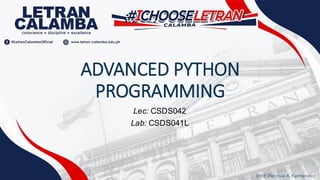
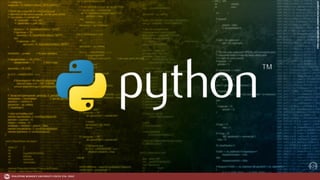
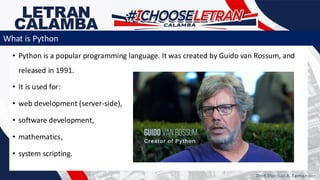




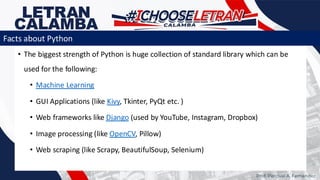

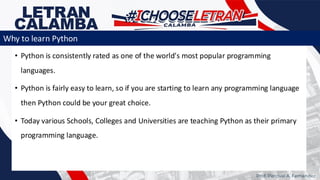


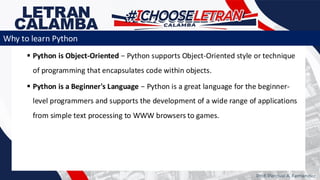
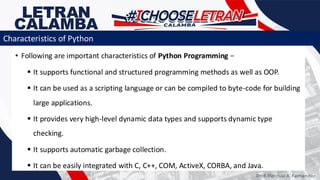







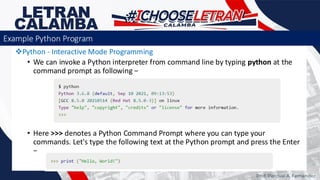



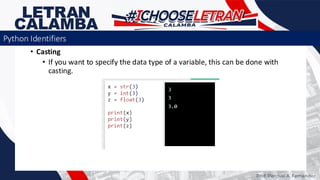
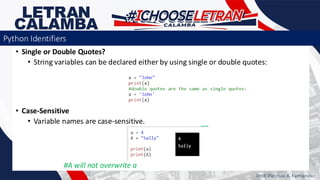



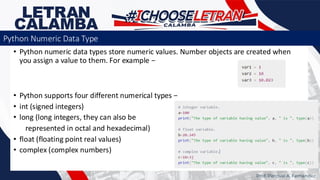
![• Python Strings are identified as a contiguous set of characters represented in the
quotation marks. Python allows for either pairs of single or double quotes.
• Subsets of strings can be taken using the slice operator ([ ] and [:] ) with indexes
starting at 0 in the beginning of the string and working their way from -1 at the end.
• The plus (+) sign is the string concatenation operator and the asterisk (*) is the
repetition operator in Python. For example −
Prof. Percival A. Fernandez
Python String Data Type](https://image.slidesharecdn.com/module1-reviewofpythonbasics-250302140234-e4e80610/85/Module-1-Review-of-Python-Basics-An-Introduction-33-320.jpg)




